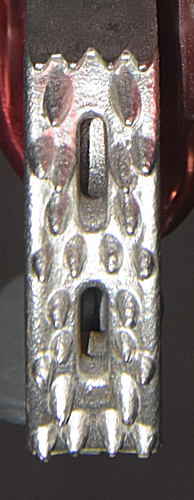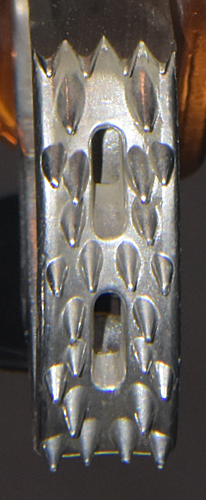Overview
[ Top
| Version B
| Return to E.C. Ascenders
]
RB16 AAA
(#1961, 2151)
Technical Details
I acquired my SOB from Xuefei Liu in 2013. I acquired another in 2017 as part of Bob Thrun’s collection.
 The ascender shell is a subtriangular
orange anodized aluminum stamping 3.4 mm. thick. The rope
channel is formed by bending the right side of the ascender into
a U. The rope channel is 17 mm. in diameter. Two indentations
in the stamping extend from the back of the ascender around the
rope channel; these would serve to strengthen the rope channel
against unrolling. The main sling attachment point is located
below the cam and behind the rope channel. A second attachment
point is located above the cam and also behind the rope channel.
The shell is bent backwards at both points to provide clearance
between the attachment slings and the main rope. This accounts
for the rather large thickness of this ascender. The lower attachment point measures 23.9 by 19.3 mm.
and the upper 20.7 by 15.7 mm. The left end of the shell is
bent on an inclined axis to form another U. A hole drilled through
both sides of the U accepts a semi-tubular rivet. The cam, cam spring,
and a spacer washer are mounted on this rivet. The head of the
rivet sits into a stamped depression on the back of the cam, while
the roll is exposed on the open side. The pivot is centered 49 mm.
from the inside of the rope channel.
The ascender shell is a subtriangular
orange anodized aluminum stamping 3.4 mm. thick. The rope
channel is formed by bending the right side of the ascender into
a U. The rope channel is 17 mm. in diameter. Two indentations
in the stamping extend from the back of the ascender around the
rope channel; these would serve to strengthen the rope channel
against unrolling. The main sling attachment point is located
below the cam and behind the rope channel. A second attachment
point is located above the cam and also behind the rope channel.
The shell is bent backwards at both points to provide clearance
between the attachment slings and the main rope. This accounts
for the rather large thickness of this ascender. The lower attachment point measures 23.9 by 19.3 mm.
and the upper 20.7 by 15.7 mm. The left end of the shell is
bent on an inclined axis to form another U. A hole drilled through
both sides of the U accepts a semi-tubular rivet. The cam, cam spring,
and a spacer washer are mounted on this rivet. The head of the
rivet sits into a stamped depression on the back of the cam, while
the roll is exposed on the open side. The pivot is centered 49 mm.
from the inside of the rope channel.
The cam is a skeletonized casting. The cam radius, measured
from the pivot, increases from 36 to 55 mm. over an angle of 36°, giving a 33° cam angle. The cam has number of small conical teeth, all
of which have their axes approximately parallel to the lower surface
of the cam. In between the teeth rows are two slots which
open to the central vacancy of the cam. The tooth/hole
pattern is (4)(1S1.2S2.1S1)(4)(1S1)^4(4). A spring-loaded
manual safety bar is mounted on the bottom of the cam. The normal action of the spring holds
the safety against the cam. When the cam is opened, the shell
interferes with the safety bar, thus preventing opening the cam.
If the safety bar is moved away from the cam (opposing the spring),
it will clear the shell and the cam will open. At full open the
safety can be released and the spring will hold the safety against
the back of the shell. This provides a means of locking the cam
open. A bent tab on the safety bar assists in operating
the safety mechanism
The front is printed with an outline of an up-pointing arrow enclosing the word "UP" and "ROPE •10≤Ø≤13." The rear is printed with a Reading-Is-Dangerous icon, "ABDR," "EN12841:2006B," "CE1282 EN567," and •Ø10-13mm - MAX 100kg."
|
 |
Warning:
The weight limit ("Max 100kg.") printed on the shell can easily be
less than the weight of a fully loaded caver. |
 |
|
The SOB is made in China by the Yue Quing Sbeng Bang Electrical Co., Ltd. (www.cnsob.com). They make a variety of equipment for electrical lineman. The shell of the SOB is sufficiently similar to the Kong-Bonaiti Cam-Clean to suspect it is a copy, but the cam is different in several ways.
In general I feel that this is a well made ascender. All sharp
edges have been removed. The cam teeth are rather well done, though
not quite as well as some of my older Petzl’s. I would polish the upper surface of the cam safety to eliminate a certain "gritty" feel when engaging or releasing the hold-open feature.
The weight limit ("Max 100kg.") printed on the rear of each ascender can easily be less than the weight of a fully loaded caver. Although I know what this means, American courts may not, so I cannot recommend this ascender for heavier cavers or for expedition caving.
[ Top
| RB16 AAA
| Return to E.C. Ascenders
]
Version B
(#2912)
Technical Details
I acquired my SOB, Version B from Strade FarEast Ltd. (perfeclan) in 2019.
The SOB, Version B is 107 mm. tall, 80 mm. wide, 30 mm. thick, and weighs 138 g. The rope channel is 16 mm. wide. The pivot is centered 47 mm. from the inside of the rope channel. The cam radius increases from 39 to 57 mm. over an angle of 39°, giving a 30° cam angle. The tooth pattern is (4.2)(2S2.1S1)(4)(1S1)^3(2.4).
 The ascender shell is a subtriangular
orange anodized aluminum stamping 3.7 mm. thick. The rope
channel is formed by bending the right side of the ascender into
a U. The rope channel is 16 mm. wide. The main sling attachment point is located
below the cam and behind the rope channel. A second attachment
point is located above the cam and also behind the rope channel.
The shell is bent backwards at both points to provide clearance
between the attachment slings and the main rope. This accounts
for the rather large thickness of this ascender. The lower attachment point measures 21.0 by 10.0 mm.
and the upper 28.9 by 17.2 mm. The left end of the shell is
bent on an inclined axis to form another U. A hole drilled through
both sides of the U accepts a semi-tubular rivet. The cam, cam spring,
and a spacer washer are mounted on this rivet. The pivot is centered 47 mm.
from the inside of the rope channel.
The ascender shell is a subtriangular
orange anodized aluminum stamping 3.7 mm. thick. The rope
channel is formed by bending the right side of the ascender into
a U. The rope channel is 16 mm. wide. The main sling attachment point is located
below the cam and behind the rope channel. A second attachment
point is located above the cam and also behind the rope channel.
The shell is bent backwards at both points to provide clearance
between the attachment slings and the main rope. This accounts
for the rather large thickness of this ascender. The lower attachment point measures 21.0 by 10.0 mm.
and the upper 28.9 by 17.2 mm. The left end of the shell is
bent on an inclined axis to form another U. A hole drilled through
both sides of the U accepts a semi-tubular rivet. The cam, cam spring,
and a spacer washer are mounted on this rivet. The pivot is centered 47 mm.
from the inside of the rope channel.
The cam and cam safety are essentially identical to those on the RB16 AAA
The front is printed with a faint outline of an up-pointing arrow enclosing the word "UP" and "ROPE O10≤Ø≤13.". The rear is printed with a Reading-Is-Dangerous icon, "ABDR," "EN12841:2006B," "CE1282 EN567," andOØ10-13mm - MAX 100kg."
|
 |
Warning:
The weight limit ("Max 100kg.") printed on the SHELL can easily be
less than the weight of a fully loaded caver. |
 |
|
This version is more compact, much like the later Petzl Crolls. Although not a major issue, I prefer the shorter version.
The shell was made of thicker material than the RRB16 AAA shell and the reinforcing ribs were eliminated. There is almost no difference between the weights of the RB16 AAA and this version.
[ Top
| RB16 AAA
| Version B
]


